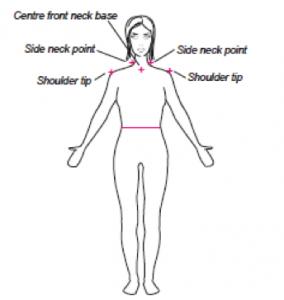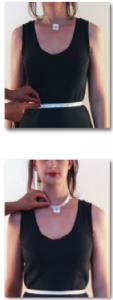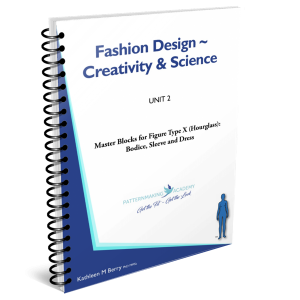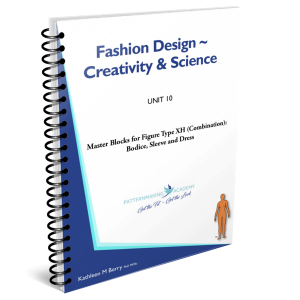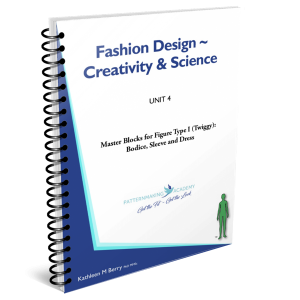Unit 01: Essential Elements of Pattern Making
$35.00
This is the first in the series of twelve units, and is a recommended text prior to following the steps and procedures in Units 2 to 11 of the Fashion Design ~ Creativity & Science [PMA’s FD~CS] series of publications.
Unit 1 provides basic knowledge of the fundamental skills of pattern making and explains the five essential elements which are applied throughout the series [54 pages].
The five essential elements are:
- anatomy [bony structure]
- morphology [shape and form]
- geometry [geometric shapes]
- mathematics [for pattern making]
- anthropometry [measurements]
(eBook)
Purchase Kindle edition here – https://amzn.to/3oO2nuT
Description
 The First Essential Element: Anatomy (bony structure)
The First Essential Element: Anatomy (bony structure)
Structural anatomy in this unit focuses on the skeletal framework of the human female body.
The skeletal framework provides pattern makers/engineers with an underlying structure that serves as a basis for locating and identifying specific regions, and equally important landmarks on the body. It is also the structural framework on which a garment is fitted.
Anatomical terms (with common names also included) are used, as they are universal.
This terminology has a number of benefits: exact parts, regions or locations on the body are more accurately identified; it ensures greater reliability by minimising technical errors; the greater the accuracy in measuring the body, the better the fit of the garment.
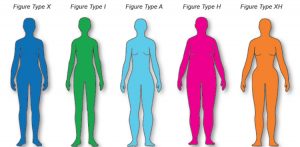 The Second Essential Element: Morphology [body shape]
The Second Essential Element: Morphology [body shape]
Morphology is a scientific term which means form, shape, and structure.
In this unit it describes the external shape and size of the human female body.
Over hundreds of centuries, the differences in body shape (morphology) within cultures and between cultures have been studied in fields such as medicine; by artists and sculptors; and as well by artisans such as master tailors and dressmakers.
Research by Berry (2001; 2013a) identified five different morphological body shapes.
These morphological shapes, termed Figure Types, are featured in the FD~CS series. The figure types are colour-coded for easy reference.
 The Third Essential Element Geometry [pattern shapes]
The Third Essential Element Geometry [pattern shapes]
Geometry relates to measurements of length, width, depth, angles and space which are essential elements of pattern making. The use of squares, rectangles, triangles, circles, cones, curves angles and circumferences are key components of the pattern drafting process.
Geometric shapes provide the means for converting a two-dimensional rectangular shape (a flat pattern on a piece of paper) into a three-dimensional form representing the shape of the body.
For this reason, some knowledge of geometrical principles is desirable for anyone interested in pattern making. Not only will it deepen the awareness of how a pattern is shaped to follow the contours of the human body, it also will enhance the ability to analyse variation in female body size and shape.

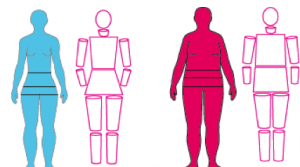
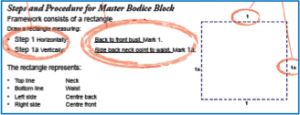 The Fourth Essential Element: Mathematics [for block making]
The Fourth Essential Element: Mathematics [for block making]
Basic mathematics are used throughout the pattern making process, particularly in the initial stage of block making.
It is essential that master blocks are drafted accurately and are fitted before creating patterns for a design.
 Simple mathematics includes not only addition, subtraction, division and multiplication, but the use of some algebra where brackets are used to separate one calculation from another.
Simple mathematics includes not only addition, subtraction, division and multiplication, but the use of some algebra where brackets are used to separate one calculation from another.
Rest assured that the drafting process requires very little knowledge of mathematics, and any necessary calculations involve just some basic addition, subtraction, division and / or multiplication.
The Fifth Essential Element: Anthropometry [measurements]
Anthropometry is described as a scientific process for measuring the human body.
In the field of pattern making, anthropometry is an essential component.
The scientific model presented here is used throughout the FD ~CS series, as it builds a framework to achieve a more accurate outcome.
Despite the adverse commentary that anthropometry ‘does not work’, in my opinion and based on experience, anthropometry can and does work when applied according to clear standards and guidelines.
The guidelines shown in the scientific model are explained as follows:
Relevant
What are the measurements for? Are they relevant to a Master block or anthropometric study?
Definable
Are the measurements clearly identified and defined? What measurements are to be taken?
Where and how are they taken?
Accurate
Are the measurements taken at the correct location on the body? Are they taken accurately as defined and described in predetermined specifications?
Valid
Is the outcome the same when the measurement is repeated by the same person?
Repeatable
Can the measurements be replicated by another person using the same procedure?
The use of Landmarks in Anthropometry
Anatomical points called landmarks assist the measurer by providing specific reference points on the body.
Before measuring begins, non-allergenic adhesive stickers marked (+) are placed at the specific locations.
